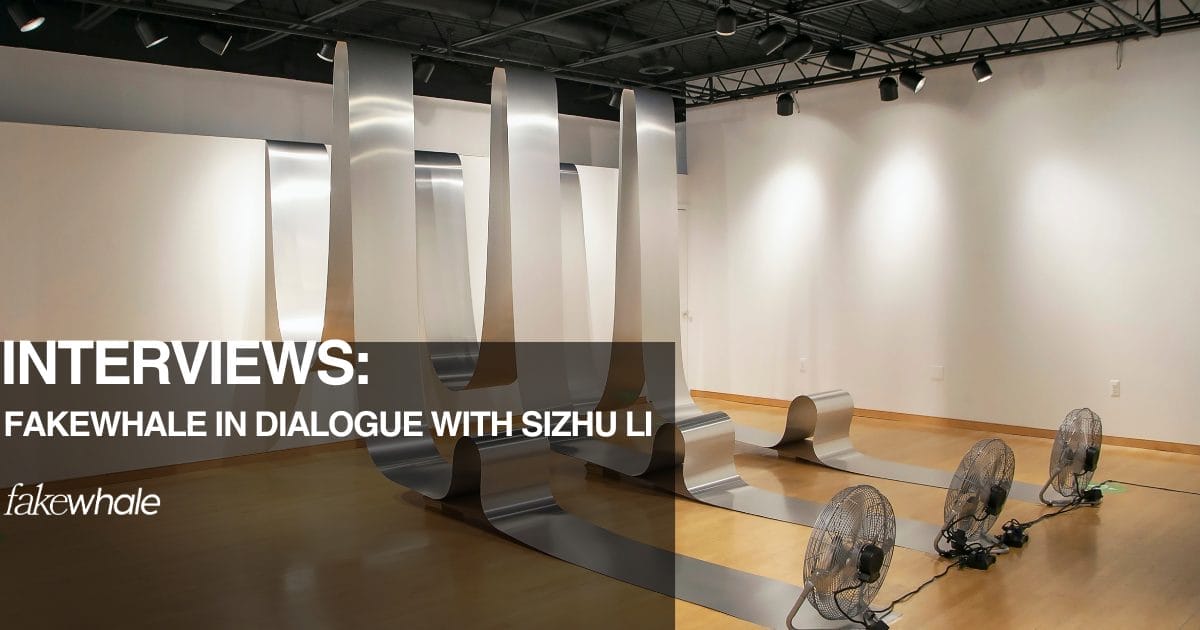Sizhu Li doesn’t simply occupy space; she redefines it. Her work moves with intention, inviting us into new dimensions of thought, rhythm, and perception.
Our INTERVIEWS section takes shape through encounters with contemporary artists and key figures of the present art scene. Through direct and unfiltered conversations, we open a window into the deepest roots of their work, seeking to capture their artistic vision in its purest form. This allows the audience to immerse themselves in a dynamic dialogue, uncovering the stories and journeys that define our time, offering an open perspective on the key themes of contemporary art and the experiences that shape it.

Sizhu Li, Dividing Lines, 2025, Contemporary at Blue Star, TX, Aluminum sheets, fans, steel, fence, wall, Dimensions variable, Ph: Jacqueline Saragoza McGilvray
Having lived and worked across two continents, Sizhu Li has cultivated a distinctive artistic language that merges kinetic movement, minimalism, and poetic storytelling. Her large-scale installations transform space into a dynamic material, where mechanized motion and rhythmic repetition create immersive landscapes. Deeply influenced by Futurism, Minimalism, and traditional Chinese philosophy, her works explore the tension between simplicity and complexity, evoking ephemeral natural phenomena within the chaos of modern life. At FakeWhale, we had the opportunity to delve into Li’s creative process, her inspirations, and the ongoing evolution of her touring project Moonment.

Sizhu Li, Moonment 2024 Aluminum sheet, motor, lifting system, wood, still rope Viborg Kunsthal, Denmark Dimensions: variable Photographers/ Photo credits: Enne Hempen
Fakewhale: Your kinetic installations often incorporate mechanical movement to create a rhythmic, almost meditative experience for the viewer. What draws you to this mode of expression, and how do you see motion as a form of storytelling?
Sizhu Li: My interest in kinetic installations really started from my multidisciplinary studies in school. Swift major from Illustration, I picked up wood class and learned some computational programming from a visiting engineer. But honestly, a lot of my early explorations were just me following my intuition, doing all kinds of “nonsense” experiments but helped me discover new directions. My work was static at first, but no matter how much I adjusted it, something always felt missing. It wasn’t until I started incorporating motion that everything clicked, I finally felt like I was on the right path.
I see motion as a form of storytelling because it instantly brings life to materials that would otherwise just sit there. Movement has this incredible ability to create a sense of presence, almost like the work becomes its own character in a scene. Storytelling needs something alive too, something that can respond or repeat in a way that resonates with people. That’s what I try to do with my kinetic installations, use rhythm, repetition, and flow to pull viewers into a moment that feels immersive and engage.

Sizhu Li, Moonment 2024 Aluminum sheet, motor, lifting system, wood, still rope Viborg Kunsthal, Denmark Dimensions: variable Photographers/ Photo credits: Enne Hempen
The concept of space in your art is fascinating, as you treat it as a tangible material, just like metal or wood. How do you approach designing an installation in relation to its environment? Do you see space as a collaborator in your work?
Creating site-specific work allows me to localize my installations to different regions, which is an important part of my artistic vision. For example, my project Moonment is a touring installation where each exhibition site becomes a pin on a map, connecting people across different places and times. Even if they experience the work separately, they become linked through shared memory. Local architecture carries the essence of a culture. When I design an installation, I consider not only the physical space but also the history, energy, and people of the place. I see space as more than a backdrop—it is a collaborator. It shapes how my work is seen, felt, and understood. Creating a piece specifically for a site, in response to its unique character, is my way of sincerely engaging with the local environment and community. (…)
READ NOW ↓
USEFUL LINKS:



